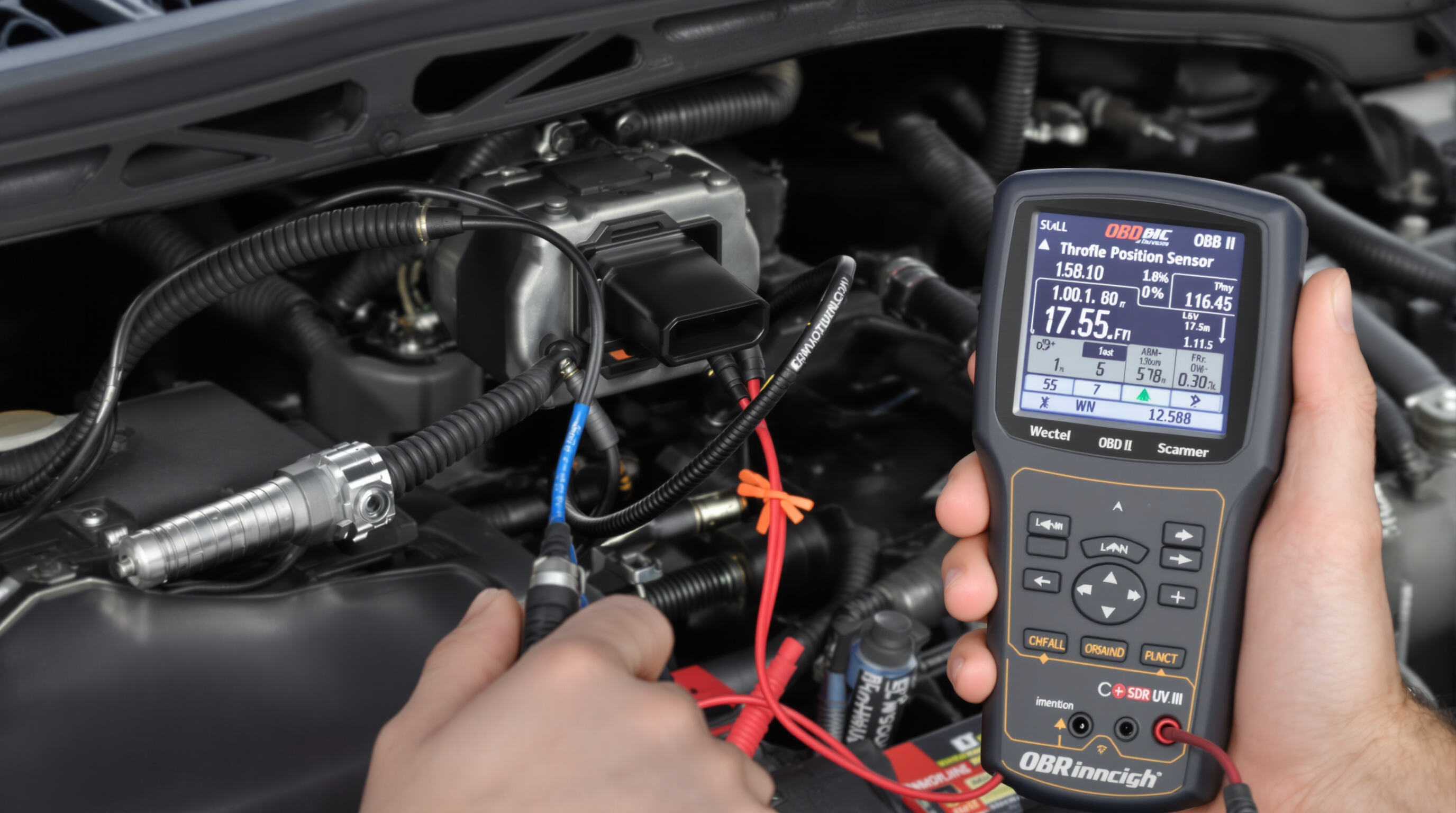Understanding the Throttle Position Sensor (TPS) and Its Core Functions
What does a Throttle Position Sensor do?
The Throttle Position Sensor, or TPS for short, keeps track of where the throttle valve is positioned at any given moment. It sends this angle information to what's called the Engine Control Unit, or ECU. What does all this mean? Well, it allows for much better control over the mix of air and fuel going into the engine, which has a direct impact on how efficiently the engine burns fuel and how smoothly the car drives overall. For vehicles equipped with modern Electronic Fuel Injection systems, the TPS plays a critical role in making sure just the right amount of fuel gets delivered when the driver opens or closes the throttle. This helps the engine respond properly whether accelerating quickly or slowing down gradually, something drivers definitely notice in their day to day driving experience.
Basic function and location of the Throttle Position Sensor
The TPS sits right there on the throttle body shaft where it acts like a variable resistor. Basically what happens is it takes those throttle plate angles and turns them into voltage signals that the car can understand. When someone steps on the gas pedal, the voltage jumps up quite a bit too. Starts around half a volt when the engine is just idling, then climbs all the way to about four and a half volts when the throttle is fully open. The ECU needs this information badly though because it helps figure out how much load the engine is under and decides how much fuel to send during those quick acceleration moments. Without proper TPS readings, the whole fuel management system would be guessing most of the time.
How Throttle Position Sensor integrates with EFI and ECU systems
Today's TPS systems produce much clearer digital signals compared to their older analog counterparts, and they respond about 5% quicker too. When the engine control unit works out what's going on, it checks the TPS information against readings from both the Mass Airflow sensor and the Manifold Absolute Pressure sensor. This helps adjust things like when the spark plugs fire, how fast the engine idles, and manages emissions properly. Take a situation where someone suddenly opens the throttle wide. The system needs to enrich the fuel mixture right away by changing how long the injectors stay open. But this kind of instant reaction can only happen if we have real time feedback from the TPS working properly.
Throttle Position Sensor's Role in Air-Fuel Mixture and Engine Efficiency

Real-Time Air-Fuel Ratio Adjustment Based on TPS Data
The throttle position sensor plays a big role in how well the engine burns fuel because it tells the computer where the throttle is positioned at any given moment. When someone presses down on the gas pedal, the voltage goes up gradually from around half a volt when closed all the way to nearly five volts when fully open. The engine control unit then uses this information to decide how much fuel should be injected into each cylinder. This helps keep things running smoothly while maintaining that sweet spot of about 14 point 7 parts air to one part fuel regardless of what's happening on the road. And interestingly enough, when paired with input from those little oxygen sensors tucked away in the exhaust system, adjustments happen incredibly fast too – sometimes as quick as fifty milliseconds after someone moves their foot on the accelerator.
Impact of TPS Performance on Fuel Efficiency and Emissions
A properly functioning TPS improves city fuel economy by 6-12% (EPA 2022) by preventing unnecessary fuel enrichment. Faulty sensors lead to incomplete combustion, increasing hydrocarbon emissions by up to 30% and nitrogen oxides by 15%. According to the Society of Automotive Engineers, inaccurate throttle position data contributes to 23% of emission test failures.
Case Study: TPS Failure Leading to Rich/Lean Mixture Conditions
A 2023 analysis of 1,200 vehicles with P0121/P0221 trouble codes found that 68% experienced lean conditions at idle (TPS readings below 0.4V) and rich mixtures under load (above 4.6V). These faults resulted in:
- 15% average drop in fuel efficiency
- 40% rise in catalytic converter temperatures
- Frequent hesitation during 25-35% throttle application
In 89% of cases, recalibration or replacement restored normal operation, highlighting the TPS essential role in mixture control.
Throttle Position Sensor and Engine Control Module Communication
How the TPS Sends Voltage Signals to the ECM Based on Throttle Angle
The Throttle Position Sensor functions like a precision potentiometer, basically converting physical movement of the throttle plate into changing voltage levels, usually somewhere between 0.5 volts and 4.5 volts. When someone steps on the gas pedal, the voltage goes up in direct relation to how far the throttle opens - starting from almost closed positions at idle speeds where the opening might be less than 10%, all the way to full acceleration when the throttle is completely open. Modern engine control modules take those continuous voltage readings and turn them into digital information using a standard 5 volt reference system. This allows vehicles to monitor exactly where the throttle is positioned in real time, sometimes down to within just one tenth of a degree accuracy in newer models equipped with high end sensors.
ECM Response to TPS Input: Ignition Timing, Idle Control, and Load Management
Upon receiving TPS data, the Engine Control Module initiates three key responses:
- Ignition timing: Advances spark by 2-6° per 10% throttle increase under load (Federal Mogul 2022 ignition studies)
- Idle air control: Activates bypass valves when throttle position drops below 2%
- Transmission load management: Commands torque converter lockup based on throttle progression rate
Closed-Loop Feedback in Modern ECU Systems for Precise Throttle Control
Modern ECUs use TPS inputs alongside MAF and oxygen sensor data to generate adaptive throttle maps, updating 50-100 times per second in direct injection engines. This closed-loop system compensates for:
- Mechanical wear in the throttle body (tolerating up to 0.2mm blade oscillation)
- Signal drift from temperature changes
- Rapid load shifts during gear changes
Compared to early open-loop systems with ±5% error tolerance, today closed-loop setups maintain ±0.8% accuracyessential for meeting EURO 7 and EPA Tier 4 standards.
TPS Among Other Engine Sensors: Hierarchy and System Integration
Comparing Throttle Position Sensor with MAF and MAP Sensors
Modern engines depend on three main sensors to get the combustion process right: the Mass Airflow sensor (MAF), the Manifold Absolute Pressure sensor (MAP), and the Throttle Position Sensor (TPS). The MAF basically tells the engine how much air is coming in, while the MAP keeps tabs on the pressure inside the intake manifold. Meanwhile, the TPS gives continuous updates about where the throttle blades are positioned at any given moment. All these signals help the Engine Control Module cross-check what it thinks is happening with what's actually going on when someone steps on the gas pedal. When drivers hit the accelerator hard, the TPS reading becomes especially important since MAF sensors can be a bit slow to react to sudden changes in airflow conditions.
Role of TPS in Engine Load Calculation and Sensor Input Prioritization
The engine control module (ECM) relies on the throttle position sensor (TPS) voltage signal to figure out what the driver wants from the vehicle. When things are running smoothly at constant speeds, the mass air flow (MAF) sensor and manifold absolute pressure (MAP) sensor take charge of calculating engine load. But when there's action happening - think sudden acceleration or climbing steep hills - the TPS suddenly becomes king of the hill in terms of input priority. Makes sense really, because when someone slams down on the gas pedal, the actual change in airflow or pressure inside the intake system takes around 100 to 300 milliseconds to register after the throttle starts opening. That delay means the ECM needs to act quickly based on what it sees from the TPS first before waiting for confirmation from other sensors.
Growing Importance of TPS Accuracy in Direct Injection and Advanced EFI Systems
When it comes to direct injection and turbocharged engines, better control over the air-fuel mix has made the Throttle Position Sensor (TPS) much more important than just being a backup component. These days, Engine Control Units are putting together information from the TPS along with where the crankshaft is positioned and what those oxygen sensors are telling them. This combination lets the system tweak when fuel gets injected down to fractions of a millisecond accuracy. According to recent studies cited in the 2024 Automotive Sensor Integration Report, even small errors in TPS readings above 2 percent can lead to worse gas mileage by around 9 percent while also boosting harmful NOx emissions by about 15 percent. As cars move away from old fashioned mechanical linkages to electronic throttle systems, the role of the TPS has expanded beyond simple monitoring. It actually helps shape how responsive the throttle feels and plays a part in keeping vehicles stable during acceleration on modern fuel injection systems.
Diagnosing and Maintaining Throttle Position Sensor Performance

Common Symptoms of a Failing TPS: Hesitation, Stalling, and Idle Issues
A failing TPS disrupts drivability, often causing hesitation during acceleration, unexpected stalling at idle, or unstable engine speeds fluctuating between 500-1,500 RPM. These issues stem from corrupted voltage signals that prevent the ECU from accurately interpreting throttle position, leading to poor air-fuel coordination.
Check Engine Light and Diagnostic Trouble Codes (P0121, P0221)
Persistent TPS faults typically trigger the Check Engine Light along with OBD-II codes. P0121 indicates inconsistent voltage between closed and wide-open throttle positions, while P0221 points to nonlinear voltage progression during throttle movement. Technicians use these codes in conjunction with live data to confirm sensor faults before replacement.
Testing TPS with a Multimeter and OBD-II Scanner
Accurate diagnosis requires two tools:
- Digital multimeter: Measures voltage at the TPS connector, verifying output between 0.5V (closed) and 4.5V (open)
-
OBD-II scanner: Monitors real-time throttle position data relative to pedal input
Deviations exceeding ±0.7V from specifications or stagnant readings during actuation confirm sensor failure.
Procedure for TPS Recalibration After Replacement
Post-replacement recalibration is essential for proper operation:
- Reset ECU adaptive memory using a bidirectional scan tool
- Perform an idle learn procedure: run engine at idle for 2 minutes with accessories off
- Confirm closed-throttle voltage reads 0.48-0.52V via scan tool
Skipping recalibration may result in idle instability or transmission-related torque converter issues.
FAQ
What are the signs of a failing Throttle Position Sensor?
Signs of a failing TPS include hesitation during acceleration, unexpected stalling at idle, unstable engine speeds, and fluctuating RPMs. The Check Engine Light may also activate along with diagnostic trouble codes.
How does the Throttle Position Sensor impact fuel efficiency?
A properly functioning TPS ensures the correct air-fuel mixture, optimizing fuel efficiency and reducing emissions. Faulty TPS can lead to incomplete combustion and increased emissions.
How do technicians diagnose TPS errors?
Technicians diagnose TPS errors using OBD-II scanners and digital multimeters to verify voltage outputs and confirm sensor faults with live data.
Why is recalibration crucial after TPS replacement?
Recalibration ensures the TPS sends accurate signals to the ECU, stabilizing idle and optimizing transmission functions. Skipping recalibration may lead to idle instability.
Table of Contents
- Understanding the Throttle Position Sensor (TPS) and Its Core Functions
- Throttle Position Sensor's Role in Air-Fuel Mixture and Engine Efficiency
- Throttle Position Sensor and Engine Control Module Communication
- TPS Among Other Engine Sensors: Hierarchy and System Integration
- Diagnosing and Maintaining Throttle Position Sensor Performance
- FAQ

